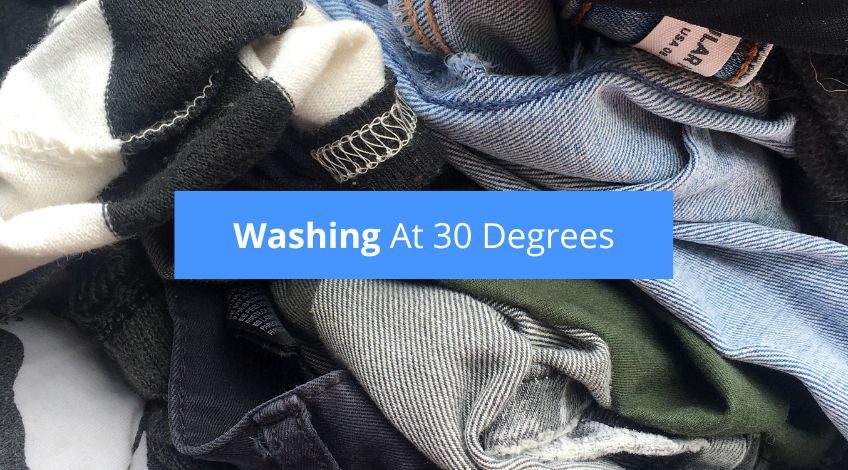
Washing At 30 Degrees? (what you need to know)
We are all looking to save energy nowadays and washing your clothes at 30 degrees uses less energy. Not only does washing clothes at 30 degrees save energy, it also treats your washing to a gentler wash. It’s convenient too as most washing detergents are designed to be used at lower temperatures.
Washing your clothes at 30 degrees can save you money as well as protecting your clothes from the stress which can be caused by hot water. Plus it keeps colours from fading too.
However, it’s not all good news, washing your laundry at 30 degrees can cause some problems.
Why You Can’t Always Wash Laundry At 30 Degrees
We’ve mentioned some of the benefits of doing the washing at 30 degrees but there are a few drawbacks too. For instance;
- If your garments are heavily stained you’ll need to soak them to remove dried in stains before washing them at 30 degrees, and even then it might take another wash to completely remove the stain.
- It costs as much washing a few items at 30 degrees as it does a full load, and only a few pence more to wash a full load at 40 degrees.
- If you always wash your clothes at 30 degrees, you’ll need to do a hot wash as a maintenance wash to remove bacteria, germs and detergent build-up from your machine, this could be avoided if you were to do a hot wash occasionally to wash towels etc.
Is It Better To Wash At 30 Or 40 Degrees?
If you look on any forum at any time, you’ll probably find a thread asking this very same question. You’ll also find some great arguments for both sides of this debate. But what’s the truth and what’s just conjecture?
We did our research and found the following;
- Wool and silk items will do better washed at 30 degrees
Washing wool and silk items at 30 degrees prevents them from shrinking and protects them from damage too. - Washing clothes at 30 degrees saves energy
As the water is heated to a lower temperature, your washing machine uses less energy. - Clothes last longer when washed at 30 degrees regularly
Clothes are less likely to wear as much when washed at 30 degrees compared to similar clothes washed at 40 degrees. - Colours are less likely to run at 30 degrees
Washing clothes at 30 degrees means less chance of the colours running compared to similar clothes washed at 40 degrees.
However, clothes always washed at 30 degrees could develop the following;
- Heavily soiled clothes are less likely to be cleaned at 30 degrees
Clothes which have ingrained stains or olive oil stains are less likely to be removed at 30 degrees. You’ll either need to soak them first or wash them twice at 30 degrees. Whereas similar stains were removed first time at 40 degrees. - Clothes washed at 30 degrees have a higher chance of bacteria growth
In particular, baby clothes which should be disinfected, need washing at 40 degrees or higher to remove bacteria.
Washing Machine Temperature Guide

If you’re still confused over which temperature you should be washing your clothes at, follow our simple guide.
Washing Clothes At 20 Degrees
Most washing machines now have a 20 degree option in fact, since 2013 all UK washing machines have been required to have a 20 degree wash cycle. If you run a cotton wash at 20 degrees, it will save an average of 60% on your energy bill (compared to washing clothes at 40 degrees). This is because the machine needs less energy to heat the water to 20 degrees.
However, washing clothes at 20 degrees can leave some stains behind, although using a liquid detergent does improve this somewhat. Remember that continuously running a washing machine at low temperatures requires a monthly service wash at high temperature to keep the machine clean and running properly.
Running The Washing Machine At 30 Degrees
As we said earlier, running the washing machine at 30 degrees protects delicate clothes and prevents colours from running as well. You will also use around 40% less energy than washing clothes at 40 degrees.
Using The 40 Degree Wash Cycle
Lower temperature washes might be great for washing most clothes, but those that are heavily soiled will need that extra temperature to remove tough stains. There are many clothes that should be washed at 40 degrees including;
- Cotton
- Acrylics
- Linen
- Viscose
What Can Be Washed At 50 Degrees?
Whilst many stains will be removed at 40 degrees, sometimes you need that extra heat to really break down tough embedded stains. 50 degrees is best for;
- Polyester/Cotton
- Cotton
- Nylon
- Viscose
Washing Clothes At 60 Degrees
60 degrees is great for removing grease stains and works especially well for towels and bedding. However, running your washing machine at 60 degrees adds a whopping 50% extra cost on your energy bill. Many viruses and some bacterias can survive a 60 degree temperature so you’ll need to add a decent detergent with germ killing capabilities, many of which work just as well at 40 degrees.
Using The 90 Degree Wash Cycle
Most washing machines have a 90 degree wash cycle even though there aren’t that many garments that could stand such a high temperature. There is no real reason for using a 90 degree program. Even the NHS[1] only recommends washing towels, underwear and bed linen at 60 degrees to prevent the spread of germs. Or 40 degrees if using a biological washing detergent.
Frequently Asked Questions
Denim jeans should be washed at no higher than 40 degrees as they can shrink and fade if washed at too high a temperature.
It is OK to wash many clothes at 30 degrees, modern detergents work well at lower temperatures and washing at 30 degrees will save energy too.
It works out to be around 40% cheaper to wash clothes at 30 degrees compared to 40 degrees.
Washing clothes at 30 degrees is considered to be cold but in reality, 30 degrees is warm. Washing clothes at 20 degrees is a cold wash.
Washing clothes using a cold wash cycle in conjunction with a decent detergent will clean clothes that are not heavily stained. If your clothes are heavily stained they might benefit from a presoak first.




